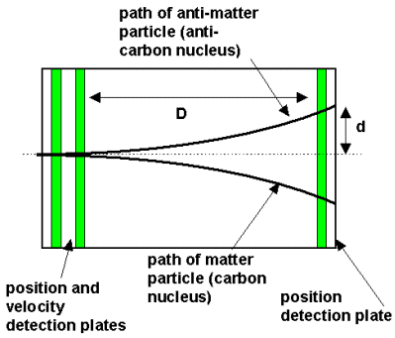
Teaching Physics with the Physics Suite
Home | Action Research Kit| Sample Problems | Resources | Product Information
Problems Sorted by Type | Problems Sorted by Subject | Problems Sorted by Chapter in UP
 |
Teaching Physics with the Physics Suite
Home | Action Research Kit| Sample Problems | Resources | Product Information |
Problems Sorted by Type | Problems Sorted by Subject | Problems Sorted by Chapter in UP |
An international consortium is presently building a device to look for anti-matter nuclei in cosmic rays to help us decide if there are galaxies made of anti-matter. Anti-matter is just like ordinary matter except the basic particles (anti-protons and anti-electrons) have opposite charge from ordinary matter counterparts. (Anti-protons are negative, and anti-electrons are positive.)
A schematic of the device is shown at the right. A cosmic ray -- say a carbon nucleus or an anti-carbon nucleus -- enters the device at the left where its position and velocity are measured. It then passes through a (reasonably uniform) magnetic field. Its path is bent in one direction if its charge is positive, in the opposite direction if its charge is negative. Its deflection is measured as it goes out of the device.

Not finding what you wanted? Check the Site Map for more information.
Page last modified October 19, 2002: MG04